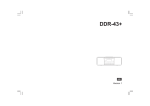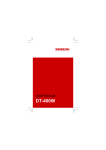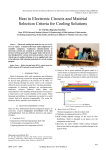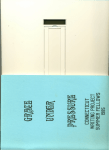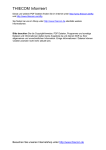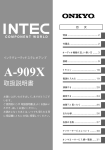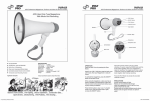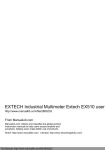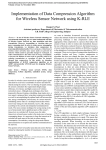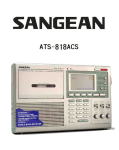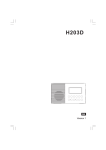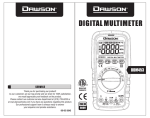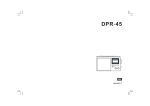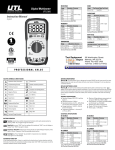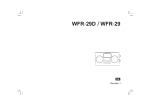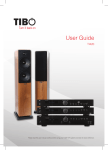Download user manual
Transcript
ATS-909X GB F E NL D Version 1 Important safety instructions 1. Read and understand all safety and operating instructions before the radio is operated. 2. Retain instruction: The safety and operating instructions should be retained for future reference. 3. Heed warnings. All warnings on the appliance and operating instructions should be followed. 4. Follow all operations and use instructions. 5. Water and moisture: The appliance should not be used near water. Do not use near a bathtub, washbowl, laundry tub, kitchen sink, wet basement, swimming pool, etc. 6. Unplug the radio from the AC power outlet before cleaning. Use only a damp cloth for cleaning the exterior of the radio. 7. Do not place the radio on an unstable cart, stand, bracket or table. The radio may fall, causing serious personal injury and damage to the radio. 8. Ventilation: This radio should be situated so that its location or position does not interfere with its proper ventilation. For example, the radio should not be used on a bed, sofa, rug or other soft surfaces that may block the ventilation openings. It should not be placed in a built-in situation like a cabinet that may reduce air flow through the ventilation openings. 1 9. Power sources: The radio should be operated only from the type of power source indicated on the marking label. If you are not sure of the type of power supply to your home, consult your radio dealer or power company. GB 10. Mains adaptor: The mains adaptor should be positioned so it is not walked on, pinched, or items placed on top of it. Pay particular attention to wires at plugs, convenience receptacles, and the point where they exit from the unit. Unplug the mains adaptor by gripping the adaptor, not the wire. Operate the radio using only the current type of power source indicated. If you are not sure of the type of power supply to your home, consult your dealer or local power company. 11. Do not overload wall outlets or extension cords. This can result in a risk of fire or electrical shock. Never insert objects of any kind into the radio through opening. The objects may touch dangerous voltage points or short out parts. This could cause a fire or electrical shock. 12. If the radio is left unattended or unused for long periods of time, unplug it from the wall outlet. This will prevent damage caused by lightning or power line surges. 13. If the radio is left unattended and unused for a long period of time, remove the batteries. The batteries may leak and damage furniture of your radio. 14. Do not attempt to serve the receiver yourself. Removing the cover may expose you to dangerous voltage, and will void the warranty. 2 15. Never push objects of any kind into this radio through opening as they may touch dangerous voltage points or short-out parts that could result in a fire or electric shock. Never spill liquid of any kind or products. 16. The appliance should be serviced by qualified service personnel when: A. The power supply cord or the plug has been damaged. B. Objects have fallen or liquid had been spilled into the radio. C. The radio has been exposed to rain or water. D. The radio does not appear to operate normally or exhibits a marked change in performance. E. The radio has been dropped, or the enclosure damaged. 3 Introduction The Sangean ATS-909X world band synthesized receiver provides the following range of features: GB Radio for FM/LW/MW/SW broadcasts 406 radio station presets (FM 3 pages: 27 presets / LW 1 page: 9 presets / MW 2 pages: 18 presets / SW 39 pages: 351 presets + 1 priority preset) 5 tuning methods: Direct frequency tuning, Auto scan, Manual tuning, Memory recall and rotary tuning Built in 42 world time & D.S.T. Device with 2 editable city names Equipped with AM wide / narrow filter and FM mono / stereo switch FM RDS with PS, PTY, RT and CT features Comes with RF gain control SSB (Single Side Band): USB / LSB 40Hz / Tuning step 3 alarm timers with snooze feature to wake you to radio alarm or HWS (Human Wake System) buzzer Large LCD screen with bright white LED backlight Battery charger recharges batteries 4 Controls Time Set Daylight Saving Time Switch 3 Home / World Time Selection 4 Loudspeaker 5 Freq – Allows direct frequency input 6 Single Side Band (SSB) / RDS / Alarm mode 7 LCD display 8 Standby / Sleep timer 9 LED charge indicator 10 Backlight 11 Squelch 12 Rotary tuning knob – Edit characters selected / Frequency adjustment / Home-world city selection / SW page selection 13 Step – Station frequency spacing 14 Tuning Up Down button – Manual tuning / Auto tuning / Page selection / Edit / Home-world time search 15 Lock switch (Locks all settings) 16 Edit / Create station name, home/world city name and page name 17 Priority – Instant recall favorite station 18 Page selection: 3 pages FM, 2 pages MW, 1 page LW, 39 pages SW 19 Enter selection 20 Memo – allows memory input 21 Selection cancel / SW 11 meter band 22 Digit input / Clock / Memory & SW meter band / Edit 23 Decimal point / SW 15 meter band / Edit 24 ATS / LW – Selects LW band / Presets all stations 25 METER / SW – Selects SW band 26 ATS / MW – Selects MW band / Presets all stations 27 ATS / FM – Selects FM band / Presets all stations 28 Timer – Alarm timers (1,2,3) 29 Aux-in switch 30 AM RF gain – Adjusts level of incoming signal to prevent overload 1 2 5 31 32 33 34 35 36 37 AM RF gain – Adjusts level of incoming signal to prevent overload AM Ext. Ant – Jack for external AM antenna Aux-in socket Rec. standby – Turn-on for external recorder Line out – Audio output Headphone jack AC in 9V – Jack for 9V AC power adapter 6 GB Controls 38 39 40 41 42 43 44 45 46 47 48 49 7 Folding stand Telescopic antenna Battery compartment Volume control Time set – Selects auto or manual mode for time set Tone – Tone control (news, music, normal) Wide narrow – AM wide / narrow filter / FM mono stereo selector Alkaline / NiMH / NiCad rechargeable battery switch MW / AM tuning step switch (9 kHz / 10 kHz switch, 9 kHz for European MW) Data A,B Data A,B Reset – Clears time & microprocessor setup GB 8 Display icon A B C D E F G H I J K L M N O P Q R S T U V W X Y Z 9 Buttons locked Home / world time Daylight saving time RDS icon Time AM mode selection Snooze icon Sleep timer icon Timer Radio wake-up HWS buzzer wake-up Selected timer Squelch Battery level indicator Signal level SW meter band Frequency Digit for memory slot Text display Memory locked Frequency display Memory presets Page Band selected Rotary tuning step FM stereo indicator GB 10 IMPORTANT (Please read before use) SW Memories The ATS-909X is supplied with 39 pages of SW memory pre-programmed. Not all of the stations pre-programmed into the memories will be receivable, some will only be receivable at certain times of the day. When selecting a page of memory the ATS-909X will scan and select the memory preset for the strongest station. At certain times the strongest station may not be from the country/station of the page selected. This happens for example when say the BBC world service is not transmitting on one of their frequencies at a particular time – the frequency then becomes available to another broadcaster. If this should occur simply press one of the preset buttons 1-9 until the desired station is received. Note: Due to the constantly changing frequencies and transmission times used on shortwave the user should contact the relevant broadcasting station for the most up to date information regarding transmission times and frequencies. POWER SUPPLY The ATS-909X operates on 4xUM-3 (AA Size) batteries. If an external adapter is used it must be capable of providing 9.0V AC, 700mA with center connector negative. 11 CHANGING BATTERIES Press and remove battery cover in the direction indicated by the arrow on the cover. Insert 4xUM-3 (AA Size) batteries with polarities exactly as shown on diagram inside the battery compartment. Slide battery cover back into place in direction of arrow until case snaps into place. GB Each time the ATS-909X is turned on the battery level indicator will remain. Batteries should be replaced when battery level drops or the level indicator flashes. Batteries must be replaced within 3 minutes to retain clock display. (Input memory will remain intact even during power failure because receiver is equipped with EEPROM memory) Note: If you use non-rechargeable batteries, before inserting the batteries make sure the Alkaline (Batteries) or NIMH/NICAD (Charger) switch (which is located inside the battery compartment) is switched to the Alkaline (Batteries) position. If you use rechargeable batteries, make sure to switch NIMH/NICAD/ Alkaline switch to the NIMH/NICAD (Charger) position. Note: You may make sure to have the same capacity of the rechargeable batteries, and then they can be balanced to full charge. 12 USING EXTERNAL AC ADAPTER The ATS-909X can be used on AC by using the adapter included with this radio. When connected, the batteries within the radio will be automatically disconnected. SETTING THE CLOCK (REAL TIME) In keeping with world wide short wave protocol time is programmed on a 24 hour basis. (Greenwich Mean Time) The clock can be set with the power on or off. The clock display will start to run as soon as batteries are inserted. Press the Time Set button. Display time digit will be blank and Home display will flash. Use digit buttons to enter the actual time in hours and minutes. (Don’t forget time must be entered on a 24 hour basis). Once entered, hours and minutes will be displayed in display. To start clock, press Enter Selection button. To cancel an incorrect entry, press the CANCEL button. One digit is deleted every time the button is pressed. 13 SETTING WORLD TIME The ATS-909X is programmed to provide the correct time for 42 cities worldwide. Each cities time is correct once your own city time zone is inserted into the system. GB Once you have inserted the correct time for your city as described previously push Home/World Time Selection button. Home display will begin to flash. Using Rotary Tuning Knob to select your city or any designated city that shares your same time zone and press Enter Selection button. Displayed city will remain for about 2 seconds and disappear. To recall home city, press Home/World Time Selection button again. Once above is completed it is only necessary to press World/Home Time Selection button and use Rotary Tuning Knob to get the correct time in any city displayed. If you would like to display and monitor another world city/time zone rather than your own home time press Home/World Time Selection button until World flashed. Rotate Rotary Tuning Knob to select World city/Time zone you would like to display and monitor. Press Enter Selection button. New time will appear and remain in display. World city name will disappear from display within 2 seconds. 14 EDIT METHOD You may program the page name, preset station name and World/Home city name you desire. Press EDIT button and use Rotary Tuning Knob or the key pad to enter the first word of the name you desire. Then press the one of the Tuning Up/Down buttons to move the next word you desire. When name is completely entered press the Enter Selection button. ADDING YOUR OWN WORLD CITY You may program each one of Home and World city of your choice into the receiver if it not among the 42 cities already programmed into the receiver. Press Home/World Time Selection button until the Home or World displays flash. Using Rotary Tuning Knob to select correct time zone required. Press EDIT button and use Rotary Tuning Knob and to enter the correct city name you desire. When name is completely entered press the Enter Selection button. 15 RADIO OPERATION The selection of radio bands FM/LW/MW/SW is made by selecting buttons 24-27. Button Band Frequency Range Wavelength 27 FM 87.5 – 108 MHz / 76 – 108 MHz / 64 - 108 MHz VHF/FM 26 LW 153 – 519 kHz / 100 – 519 kHz Long Wave 25 AM / MW 520 – 1710 kHz / 522 – 1710 kHz Medium Wave 24 SW 1711 – 29999 kHz Short Wave GB 16 TECHNICAL DATA WAVEBANDS FREQUENCY (MHz) FM (VHF) 87.5 – 108 MHz (USA version) 76 – 108 MHz (European version) 64 - 108 MHz (Russian version) Auto scan step: 0.05 MHz AM / MW AM: 520 – 1710 kHz (USA version) MW: 522 – 1710 kHz (European version) LW 153 – 519 kHz (USA version) 100 – 519 kHz (European version) SW (Short Wave)1.711 – 29.999MHz The ATS-909X is a continuously tunable receiver from 153 kHz – 29999 kHz (by manual tuning). This receiver is capable of receiving and tuning all the short wave bands and any stations in between. Note: The tuning seek only cyclically scan when do scanning in any meter band. 17 TUNING METHODS This receiver offers 5 methods of frequency tuning: ATS-Auto Tuning This system automatically sets your memory presets based upon the signal strength of the received station Direct Tuning Frequency of desired station is entered into receiver using key pad on receiver Manual Tuning Station is selected by manually using Rotary Tuning Knob, or short press (under 0.5s) Tuning Up/Down button Scan Tuning Pressing and momentarily holding the Tuning Up/Down buttons will automatically scan frequency band and stop when a station is detected Memory Tuning Stations preselected using memory will be selected merely by pressing digital button on the key pad GB 18 ATS – Automatic Tuning System The ATS-909X features an automatic tuning system that will quickly and automatically set all your memory presets on FM, LW and MW based upon the signal strength of the incoming stations. Among the many conveniences offered by this feature it is especially useful for the traveler who can automatically find all the local stations in any strange city he/she may travel to with just the press of a button. To start ATS press and hold for more than 2 seconds the button designated ATS/FM or ATS/LW or ATS/MW. The memory presets M1 through M9 are assigned stations selected automatically by the ATS system. The ATS system will automatically store 18 presets on MW, 27 presets on FM and 9 presets on LW. (9 presets on each page. Once the ATS has set the 9 presets on 1 page press the PAGE button to change pages and repeat the ATS procedure to select the remaining presets). An audible signal indicates the automatic search has been completed and the presets have been assigned. ATS is not possible on the SW band. DIRECT TUNING USING KEY PAD If you know the frequency of the station you are seeking press FREQ button and enter the frequency you desire directly using the numerical key pad. Don’t forget to use the decimal point button if the frequency you are entering has a decimal point in its frequency. Press the Enter Selection button to enter the frequency. 19 MANUAL TUNING (ROTARY TUNING) Manual Tuning is accomplished using the convenient Rotary Tuning Knob. GB The Step button is used to determine the tuning spread for each step of the Rotary Tuning Knob. Spread may be changing accordingly: Press and release the Step button to select the step in FAST or SLOW mode. Press and hold Step button to stop or enable the step in FAST or SLOW mode. TUNING STEP ON EACH BAND STEP FM LW MW SW LSB/USB STOP 0 0 0 0 0 FAST 100 kHz 9 kHz 9/10 kHz 5 kHz 1 kHz SLOW 50 kHz 1 kHz 1 kHz 1 kHz 40 kHz AUTO/MANUAL SCAN TUNING To start Auto Scan Tuning, select band to tune press one of the Tuning Up/Down buttons for more than 0.5 second. Once scan starts, release button. The Auto Scan stops as soon as a station of adequate signal strength is located. Repeat operation to start scan tuning again. Scan tuning can be halted by pressing the Tuning Up/Down buttons momentarily any time during the scanning process. To manually tune to a frequency of your choice repeatedly, press and release one of the Tuning Up/Down buttons until the frequency desired is displayed. 20 MEMORY TUNING It is possible to preset up to 406 stations using the memory capability of the ATS-909X. Each 9 presets compromise 1 page. The SW band is capable of storing 39 pages or 351 preset stations (39 Pages x 9 Presets/Page): 27 Presets on FM (3 Pages x 9 Presets), 18 Presets on MW (2 Pages x 9 Presets) and 9 presets on LW. To Manually Set Memory on FM/MW/LW Bands: Tune to station you would like to program into memory. Press Memo button, MEMO will flash in the LCD display, select page desired by pressing PAGE button. Display will flash and next available position on display will flash if an available position is available. If memory is full no suggested position will flash and LCD will display MEMO FULL when any button is depressed. Press the Enter Selection button to assign new frequency to available flashing open position. If selected button is held for more than 2 seconds, even with MEMO FULL flashing, newly selected station will replace existing station. 21 To Manually Set Memory on SW Band: Tune to station you would like to program into memory. Press Memo button, MEMO will flash in the LCD display. Select page desired by using the PAGE button and Rotary Tuning Knob. Display will flash and next available position on display will flash if an available position is available. Press Enter Selection button to assign frequency to flashing available position. If memory is full no suggested position will flash and LCD will display MEMO FULL when any button is depressed. If selected button is held for more than 2 seconds, even with MEMO FULL flashing. Newly selected station will replace existing station. GB You may change or initiate any page name at any time by first selecting the page and then pressing the EDIT button and using the Rotary Tuning Knob to place an alphanumeric character in the name space in the LCD Display. Once a character is selected you may move to the next position to place another character by using the Tuning Up/Down button. When name is completely entered press Enter Selection button. Note: You may change and edit your SW band’s pages names, but there is no FM/MW/LW page name. You may change and edit your FM/MW/LW bands’ preset names, but there is no any SW preset name. Note: Every memory preset memory can be stored including its frequency, mode (AM/LSB/USB), and fine tuning frequency. 22 RECALLING A STATION IN MEMORY On LW, press ATS/LW button, then press any of the numbered buttons on the key pad. On MW/FM, press ATS/MW button or press ATS/FM button, select desired page by pressing PAGE button and then press any of the numbered button on the key pad. On SW, press METER/SW button, select desired page by pressing PAGE button and rotating the Rotary Tuning Knob until desired page is selected and then press Enter Selection button. The receiver will then automatically search for the strongest frequency on that page. You may change the selected frequency using the numbered keys on the key pad. CANCELING A STATION IN MEMORY Recall the station in memory, press the MEMO button and then press the Cancel button (C button). To LOCK A STATION INTO MEMORY After programming your stations into memory you may lock any station into memory to prevent accidental erasure or elimination should the ATS feature be turned on again. To lock a station, recall the station you wish to lock and press MEMO button and then LOCK button. The display will show memo locked symbol whenever the station is selected. To remove station from locked position repeat above procedure and locked symbol will be removed and a station will no longer in locked state. 23 EXCHANGING STATION POSITIONS IN MEMORY To move a station, in memory to another position recall station. Press Memo button, MEMO and position display will flash, press new position desired and a signal will be heard indicating the exchange has taken place and the positions have been swapped. GB SELECTING AN SW BAND To select an SW Band, press METER/SW button once and then press a second time. A flashing m will appear in the display. Any of the 14 SW bands (11-120m) can now be selected using the numerical keys on the key pad. The band selected appears in the LCD display and will remain in the display as long as tuning activity remains within the metered band. To start Auto Scan Tuning, select an SW band to tune, press one of the Tuning Up/Down buttons for more than 0.5 second. Once scan starts, release the button. The Auto Scan stops as soon as an SW station of adequate signal strength is located. Repeat operation to start scan again. Scan can be halted by pressing the Tuning Up/Down buttons momentarily any time during the scanning process. The range scan for SW station is being circulated as a loop within the meter band unless you continue pressing the one of the Tuning Up/Down buttons till the frequency across out of the meter band range. To manually tune to a frequency of your choice repeatedly, press and release one of the Tuning Up/Down buttons until the frequency desired is displayed. 24 Note: The SW meter Band ranges are indicated in a convenient chart below the LCD display. KEY PAD INPUT SHORT WAVE BAND 1 120m 2 90 m 3 75 m FREQ 60 m 4 49 m 5 41 m 6 31 m MEMO 25 m 7 21 m 8 19 m 9 16 m . 15 m 0 13 m CANCEL 11 m 25 FREQUENCY (MHz) 2.300 – 2.495 3.200 – 3.400 3.900 – 4.000 4.750 – 5.060 5.900 – 6.200 7.100 – 7.350 9.400 – 9.990 11.600 – 12.100 13.500 – 13.870 15.100 – 15.800 17.480 – 17.900 18.900 – 19.020 21.450 – 21.750 25.600 – 26.100 PRIORITY BUTTON (Instant Priority) The PRIORITY button allows instant program and recall to your favorite station from any frequency across any band or receiving any mode by simply pressing one button. To program the Priority button for recall your favorite station, press Memo button, the MEMO will flash in the LCD display and then press PRIORITY button. GB SQUELCH Background noise or static is present to some degree at every location. This is a normal condition. If you set the squelch above the background noise level, the radio will remain silent until a voice transmission is detected. It is best to set the squelch as low as possible (to just before static is constant). This way you can hear signals that may be weak. If you set the squelch too high, you may miss some weak voice transmissions. To adjust the squelch level, press the Squelch button until SQUELCH flashes on the display. Then rotate the Tuning Control Knob slowly clockwise from OFF through 12 (increasing squelch) until the radio just becomes silent. When the level control for the squelch threshold is set, only signals above the Squelch threshold will be stopped. 26 ALARM FUNCTION The ATS-909X has three timer circuits as indicated by TIMER buttons. The alarm functions may be set with the power on or off. To set the alarm, press one of the three TIMER buttons. The timer and button number will flash in the LCD display along with the icon indicating radio or buzzer for approximately 12 seconds. Select radio or buzzer by pressing (SSB) / RDS / Alarm mode button. While flashing continues, you may set time (hours and minutes) for alarm using the numerical keys on the key pad. When complete press Enter Selection button. When the sounds beep it means the alarm has been activated. Repeat steps for other timers. Note: If you select the buzzer as your alarm, once it is active, the volume will not be adjustable but by HWS (Human Wake System), which makes the alarm bell go from soft to loud. If you select the radio as your alarm, once it is active, the volume will be adjustable by the volume control. 27 Note: When the buzzer alarm activates, the alarm will start softly and gradually increase in level. It will sound for 1 minute and silence for 1 minute in repetition for 30 minutes unless cancelled. The radio will sound non-stop at the selected time for up to 60 minutes for other radio alarm types. GB To set radio for an alarm timer, first press one of the TIMER buttons and (SSB) / RDS / Alarm MODE button until Radio Alarm icon flashes on the display. Then set up the alarm time (hours and minutes) by using the numerical keys on the key pad and Enter Selection button. When the sounds beep it means the alarm has been activated. Then tune to the station you would like to be awaken to. Press the Memo button and then press the TIMER button number. When the sounds beep it means the alarm has been activated. Your radio will automatically switch on at the setup time. In addition to being able to set 3 different wake up times it is possible to set each wake up time to a different frequency. To view the setting of an active timer, press the required TIMER button. The timer number and the alarm time or the radio alarm frequency can be viewed flashing in the LCD display. The active alarm may be stopped by pressing the STANDBY/SLEEP button. To permanently disable the alarm, press the required TIMER button number followed by the Cancel button. Then the timer number will disappear on the display. 28 SNOOZE FUNCTION The radio or buzzer alarm can be silenced for 5 minutes by pressing any button (except STANDBY/SLEEP or LCD DISPLAY LIGHT). This sequence can be repeated during the alarm period. The Snooze function is indicated with an icon in the display. SETTING THE SLEEP TIMER (AUTO SHUT-OFF) The sleep timer allows the user to set the auto-shut off in 10 minutes decrements from 90 minutes to 10 minutes. To set auto shut-off, press STANDBY/SLEEP button and hold down. The display will show a bed symbol and a series of switch off times descending in time as long as the STANDBY/SLEEP button is pressed. Release button when shut off time desired is reached. Radio will remain on for selected length of time. 29 RDS FUNCTION The ATS-909X incorporates circuitry to receive FM stations transmitting an RDS (Radio Data System) signal. When receiving an RDS station the display will show the station call letters and if the RDS station is also transmitting a CT function (clock time) it will automatically correct the time every minute. It is important to make sure that the Home Time (as described under “SETTING THE CLOCK (REAL TIME)” is set correctly. In addition if your time zone is operating under Daylight Savings Time make sure the DST (Daylight Savings Time) function is disabled. For the clock time function to operate the following conditions must exist: GB a. TIME SET switch must be set in the AUTO position. b. Radio must be on FM band. c. Radio must be tuned to an FM station transmitting RDS CT function. Besides, repeatedly press and release the Single Side Band (SSB) / RDS / Alarm mode button to view the RDS other information of the station you are listening to. a. Station name b. Program type c. Radio text Displays the name of the station being l istened to. Displays the type of station being listened to such as Pop, Classic, News, etc. Displays radio text messages such as new items etc. Note: When receiving an RDS station, the RDS is indicated with an icon in the display. 30 SINGLE SIDE BAND (SSB) RECEPTION SSB is very popular among ham and business radio users because of its signal intelligibility superiority. Many amateurs who operate SSB and transmit below 10 MHz generally use the lower side band (LSB) while amateur and commercial stations transmitting above 10 MHz generally use the USB. Your ATS-909X is equipped to receive all USB and LSB transmissions. To receive SSB stations: 1) Turn the set on. 2) Extend the telescoping antenna full length and position upright or use external antenna 3) Set the RF Gain Control to maximum 4) Select the SW band as described in “SELECTING AN SW BAND” 5) If frequency of SSB station sought is known enter the frequency in accordance with earlier instructions. 6) You may also scan the band for SSB stations by slowly rotating the Rotary Tuning Knob through the selected band, tuning for the best intelligibility and watching for deflections on the Signal Level Indicator in the display. SSB transmit with a “suppressed carrier” meaning the Signal Level Indicator in the display will fluctuate only when there is a voice transmission and not during pauses in voice transmission. 7) As soon as you have located a SSB station (you will not be able to understand the speech) switch to SSB reception by depressing the Mode button. Continue pressing of the Mode button will alternate between USB and LSB. Try LSB for frequencies below 10 MHz or USB for frequencies above 10 MHz. 8) After tuning for maximum intelligibility switch STEP switch to Slow position and readjust Rotary Tuning Knob for maximum intelligibility. 31 DAYLIGHT SAVING TIME Daylight saving time is the practice of temporarily advancing clocks during the summertime so that afternoons have more daylight and mornings have less. Press the Daylight Saving Time switch and the radio clock time will be adjusted one hour forward. GB SWITCH SETTING AM NARROW/WIDE For normal operation it is suggested that this switch be used in the wide position. If occasion arises where an adjacent station interferes with the station being listened to the AM Narrow/Wide switch should be put into the narrow position. However, the above applies to AM bandwidth in AM mode only, not for SSB (LSB or USB) mode. For SSB (LSB or USB) mode, the station is only being put into the narrow position. STEREO RECEPTION The ATS-909X is designed to receive FM stereo broadcasts with headphones connected to the stereo headphone jack. Switch FM STEREO/MONO must be placed in the stereo position. Stereo icon will appear in the LCD display if headphones are connected. TONE CONTROL You can adjust the tone performance of your radio depending on the type of radio program you are listening to. Switch the Tone Control switch to News mode for listening to news program or AM band to reduce the hiss noise from the background, and switch to Music mode for listening to music program for enhancing the musicality effects. For normal listening tone switch to Norm mode. VOLUME CONTROL To adjust the volume set volume control to a comfortable position. Make sure that control is set to an adequate level when radio is set for waking up. 32 OPERATING LOCK The operating lock prevents unintentional altering of any of the functions once set or accidently turning off the radio. Once set the STANDBY/SLEEP button and all tuning operations become unalterable and can not be reactivated until the lock switch is turned off. It is a good policy to turn on the lock switch when transporting the radio as it will prevent the radio from being turned on accidently while in a bag or suitcase. To turn the lock switch, press the lock switch button. When the lock switch is the ON position a lock symbol will appear in the display. To unlock radio, press lock switch button again. This will unlock the radio and remove the lock symbol from the display. AERIALS The ATS-909X comes equipped with a integrated ferrite antenna built into the radio that should provide more than adequate reception for the MW and LW bands. For FM reception, it is advised that the telescopic antenna be extended and adjusted in length and direction for maximum results. Included with the ATS-909X is the Sangean ANT-60 Portable SW Antenna. The antenna is plugged into jack labeled AM EXT ANT. When fully extended this antenna should improve SW reception. For maximum performance this antenna should be placed as high as possible above the ground and in an unobstructed area if possible. Aux-in A 3.5mm stereo Auxiliary Input socket is provided on the left hand side of your radio to permit an audio signal to be fed into the unit from an external audio device such as iPod, MP3 or CD player. Just connect the external audio and turn on the radio. Press the Aux in switch then you can play the external audio device with your ATS-909X now. Adjust the volume control on the radio as needed. 33 MW /AM STEP In Europe and most other parts of the world set the switch to the 9 kHz position. For the America set the switch to the 10 kHz position. REC STANDBY/LINE-OUT The jacks on the left side of the radio are for audio output (Line-out) and a timer activation (Standby out) to control external recorder. GB The ATS-909X has 3 timers which can be set for radio alarm and can also trigger recording standby out to control external recorder as Sangean’s DAR-101. You can connect an external audio device to record or play the programs received by the ATS-909X. You can also set up a recording preset using the alarm function of the radio at the same time. Regarding the setting up of the radio alarm function, you may refer to above procedure. To record or play the programs received by the ATS-909X, connect between the Line-out jack of the ATS-909X and the Line-in (or Aux-in) jack of the external recorder via a stereo 3.5Φmm wire. Also to trigger standby out to control external recorder, connect between the Standby out jack of the ATS-909X and the remote jack of the external recorder as Sangean’s DAR-101 via a 3.5Φmm plug into the audio input jack of the recording device. 34 1. LINE-OUT JACK The Line-out jack, is used to output the audio from the ATS-909X to another device such as a recorder, your home stereo, or some other units. To do this, you will need a 1/8" stereo patch cord. Note: The Line-out jack differs from a headphone jack because the volume level of a headphone jack varies depending on the volume of the radio. The Line-out jack has a set line level so the volume is consistent no matter what the position of the volume knob. 1) Plug your patch cord into the Line-out jack on the ATS-909X. 2) Plug the other end of the patch cord into the Line-in or Audio in of the device you want to send the audio to and you will hear the radio through the other source. You can still listen to the ATS-909X while using the Line-out jack. Warning: If a “Line-out” is not available on your external audio source, you can use the headphone jack. However, the volume must be kept low or damage to the ATS-909X may result. 35 2. TIMER ACTIVATION (STANDBY OUT) The jack is for use with a recorder that has a timer activated switch. You would use this switch if you wanted to do a timed recording. It is used in conjunction with the Line-out jack. See your recorder’s instructions to determine if this function will work with your recorder. GB Note: The ATS-909X radio can trigger the above function for an hour. Note: If you don’t connect the standby out jack to your recorder for a timed recording, you may turn on your recorder to record manually. HEADPHONE SOCKET A 3.5mm stereo Headphone Socket is provided on the left hand side of your radio for use with headphones. Inserting a plug automatically mutes the internal loudspeaker. AM RF GAIN The distortion while listening to AM band can be reduced by adjusting level of the incoming signal using the AM RF Gain control. LCD DISPLAY LIGHT Backlight button is used to illuminate the display when it becomes too dark to see the display. The light will remain on approximately 12 seconds after initiated or will extinguish any other function be activated. If an AC adapter is being used the LCD display will be illuminated continuously while the radio is in operation. 36 SOFTWARE VERSION The software display cannot be altered and is just for your reference. 1. Press and release the Standby button to ensure the radio is off. 2. Press and release the Enter selection button then the display shows your radio software information. RESET SWITCH The Reset Switch situated at the bottom of the receiver case will reset the Time and Microprocessor only. All memory presets will remain intact. Reprogram time in accordance to earlier instructions. DATA IN (A/B) Data in A & B terminals next to reset switch which are for factory data input and useless for users. 37 Specification Power Requirements GB Batteries: 4 x UM3 (AA Size) External Power Supply: 9V AC 700mA / Negative Polarity Center Polarity Center Dimensions in inches: (W x H x D): 7 3/4 X 5 1/4 x 1 1/2 Weight in oz: 28 Circuit Features Speaker: 3” / 8Ω / 3W Output Power: 1W If at any time in the future you should need to dispose of this product please note that: Waste electrical products should not be disposed of with household waste. Please recycle where facilities exist. Check with your Local Authority or retailer for recycling advice. (Waste Electrical and Electronic Equipment Directive) 38 39








































